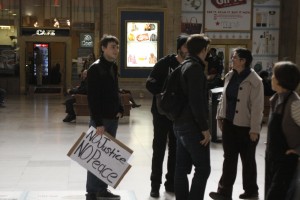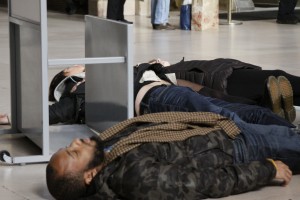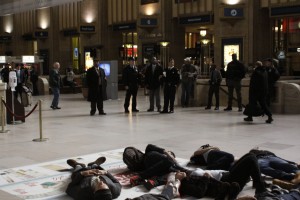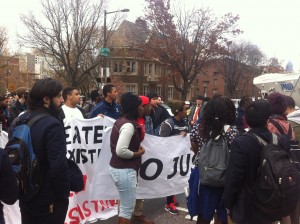
Almost 20 Drexel students staged a sit-in protest in 30th Street Station Dec. 4. in response to the grand jury decision to not indict Daniel Pantaleo, a 29-year-old New York Police Department officer who killed 43-year-old Eric Garner in a chokehold while attempting to arrest Garner for selling loose cigarettes on Staten Island. The incident was captured on video.
The protestors gathered on the 30th Street side of the large station, inciting the attention of many of the police officers patrolling the area. They lay down on the ground, holding signs saying “No Justice, No Peace” and “Black Lives Matter.”
The protest was organized by freshman photography major Costa Sardelis, inspired by the In Defense of Black Bodies protest on Dec. 3. He saw the protest on his social media feed and decided to walk with them to City Hall.
“I was there last night thinking, ‘No one from Drexel knew about this’ — Well, I presumed because most of the crowd was at least 25 years old,” Sardelis said. He returned home set on starting a Drexel protest, opening a Facebook page at 1:30 a.m. and inviting people to join; his main goal being to bring awareness on the situation.
This grand jury decision comes a little after the Nov. 22 grand jury decision to not indict now-retired 28-year-old St. Louis Police Officer Darren Wilson in the Aug. 9 shooting death of 18-year-old-Ferguson, Missouri, resident Michael Brown. According to the Drexel students, they were not only protesting the decision in Pantaleo’s allegations, but also the decision in Wilson’s allegations and the shooting of 12-year-old Tamir Rice for waving an airsoft replica gun by 26-year-old Timothy Loehmann in Cleveland, Ohio Nov. 22, the same day the grand jury in Missouri chose not to indict Wilson. Surveillance footage released days later sparked more protests on that.

The protestors in 30th Street Station Dec. 4 lay on the ground for four and a half minutes, representing the amount of time that Brown’s body was left on the street by the St. Louis Police Department. This protest strongly resembled the one on the afternoon of Dec. 1 by the Students Organizing for Unity and Liberation group of the University of Pennsylvania. The Dec. 1 protest began only in response to the grand jury decision for Brown and began in City Hall and moved back to University City.
The Dec. 1 protesters, attempting to address the perceived injustice in the grand jury decision in the Brown shooting, had a sit-in along the streets from City Hall to 33rd and Market streets, lying down to stop traffic at 34th and Walnut streets and 33rd and Market streets for four minutes. They held up banners, one of which said, “No Justice No Peace.” They halted at 34th and Walnut streets.
Some people passing had joined and lay down on the ground with the Dec. 4 protestors. Others stood on and watched the people lie on the ground while other ignored them, continuing on to their scheduled train or checking the train listings past the protestors for their times. After their laying on the ground and grabbing the attention of every police officer in the station, with the officer numbers crowding around the protestors at a distance and watching, they got up without a word and left to go to City Hall, to continue their protest.

“Not going to lie, I was like ‘Holy sh-t, they’re expecting something as big as yesterday,’” Sardelis said, “At the same time, I felt good that it was getting that much attention … there was around five times as many police officers and Amtrak police as there were protestors.” The police, however, never interfered with the protest or address them. They simply watched from afar.
After leaving, the station seemed calm and collected, with an undertone of chatter about the protestors and the recent events that have been happening around the country surrounding even larger protests about the killings of African-American citizens around the country.
Sardelis and his group stationed themselves by the Christmas tree, where they were approached by many people, curious about they were doing, approving, or disapproving about their stance on the issue.
“I felt very accomplished, going. I felt that I personally talked to 15 or 20 people who genuinely didn’t know and then [agreed with us], which was the whole point,” Sardelis said.
Although In Defense of Black Bodies was where he got the inspiration for his protest, Sardelis had some disagreements with which they had conducted their protests, likening them to the Black Panthers. “It’s very, ‘This is an organization that’s run by African American citizens and decisions will be made by African-American citizens and all those participating need to shut up and go with it,’” he said, citing their Dec. 3 protest, where they asked all non-African-American protestors to only sit while the African-Americans lay down in respect of who the killings most seriously affect.
“Little things like that people get hesitant about like, ‘Okay, I don’t think this is how I agree with it,’ but for me, if you believe in the cause, there’s something out there you can do,” Sardelis continued, explaining to that’s why he organized his protest. However, he also credited the fact that they remained focused on the specific issues surrounding on the recent killings.
Michael Brown’s shooting had sparked protests all around the country challenging similar police shootings of African-American citizens. People taking sides with both Brown and Wilson have gained international attention. Similar protests were especially intense in the small town of Ferguson, where the shooting occurred. Protesters were accused of looting and property damage and the police were accused of excessive force, using tear gas and rubber bullets. After the grand jury made the decision not to indict Wilson on any charges, protests escalated, with accusations of people setting local properties and police cars on fire. Protests spread to almost every major city in the country, the phrase “Black Lives Matter” blowing up on social media.
The decision in Garner’s case had sparked even greater protests, especially in the city of New York, where the killing happened. The justice department of New York agreed to open a civil rights inquiry into the case. NYC Mayor Bill de Blasio announced a pilot program to put body cameras on police officers to record encounters on patrol. On Dec. 1, President Barack Obama met with civil rights leaders to start a three-year $263 million initiative on police reforming, expanding training for police officers and a $75 million project to equip 50,000 police officers with body cameras.

The protests were held all over NYC, with groups stopping down Grand Central Station, chanting “I can’t breathe,” the phrase repeated by Garner 11 times as he was put in a choke hold by Pantaleo. That same phrase also went viral on social media like “Black Lives Matter.” This also went on at several Christmas tree lightings around the city, including the one by the Rockefeller Center.
Jose Romero, a senior anthropology major from UPenn, said he had walked into the Dec. 1 protest after watching it pass by 38th Street, being inspired by a “collective sense of dissatisfaction with feeling like we belong on the sidewalk when these are our streets.”
Sardelis plans to continue more protests, trying to gain connection at other protests organized by other groups such as In Defense of Black Bodies in the future.
https://www.youtube.com/watch?v=6OOFS9uu2Q0


